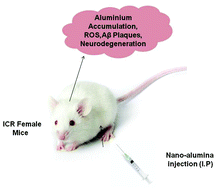Nanoscale-alumina induces oxidative stress and accelerates amyloid beta (Aβ) production in ICR female mice
Abstract
The adverse effects of nanoscale-alumina (Al2O3-NPs) have been previously demonstrated in both in vitro and in vivo studies, whereas little is known about their mechanism of neurotoxicity. It is the goal of this research to determine the toxic effects of nano-alumina on human neuroblastoma SH-SY5Y and mouse hippocampal HT22 cells in vitro and on ICR female mice in vivo. Nano-alumina displayed toxic effects on SH-SY5Y cell lines in three different concentrations also increased aluminium abundance and induced oxidative stress in HT22 cells. Nano-alumina peripherally administered to ICR female mice for three weeks increased brain aluminium and ROS production, disturbing brain energy homeostasis, and led to the impairment of hippocampus-dependent memory. Most importantly, these nano-particles induced Alzheimer disease (AD) neuropathology by enhancing the amyloidogenic pathway of Amyloid Beta (Aβ) production, aggregation and implied the progression of neurodegeneration in the cortex and hippocampus of these mice. In conclusion, these data demonstrate that nano-alumina is toxic to both cells and female mice and that prolonged exposure may heighten the chances of developing a neurodegenerative disease, such as AD.


 Please wait while we load your content...
Please wait while we load your content...